
Editor’s Note: This story originally appeared on LawnStarter.
Dreaming of morning strolls along the garden path, sipping your coffee, and smelling the gardenia blooms? Or mid-afternoon jaunts to pick fresh produce for dinner?
But then the realization hits, and you remember you don’t actually have a garden path.
Don’t worry. We’ve got you covered! Let’s discuss materials for a garden path in your yard.
12 Garden Path Ideas
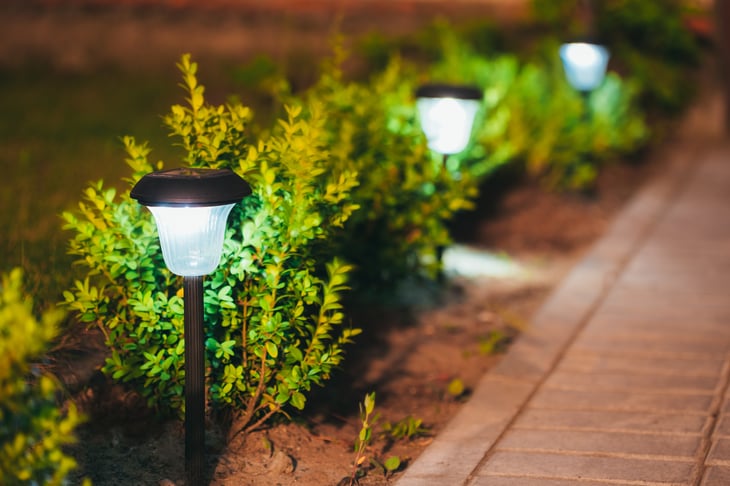
Whether you’re sitting looking at the snow outside your front window or it’s simply still too cold to get outside and do yard work, now is a fantastic time to start planning your upcoming garden projects.
While the days are still cold and gloomy, choose your pathway material from the comfort of your living room, so you’re ready to go once the warm weather arrives!
Many of these options are listed in our article on the best kinds of driveways. After all, garden pathways are a miniature version!
1. Mulch
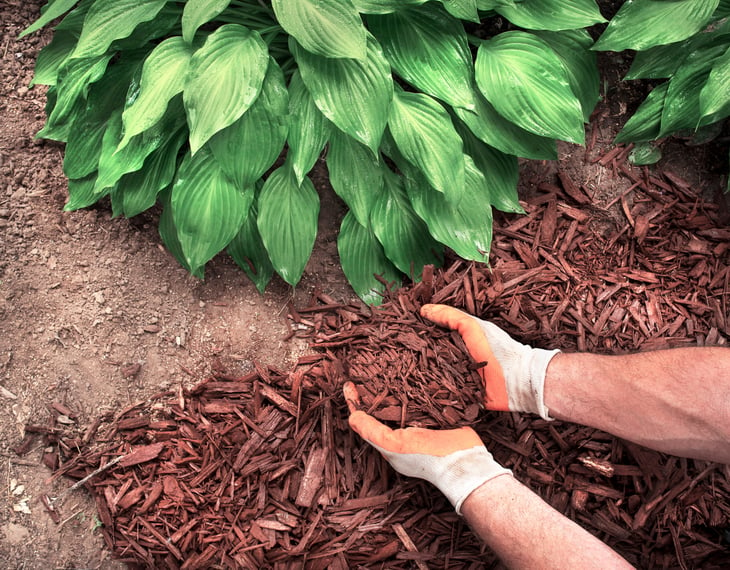
Average Cost: $17 to $68 per cubic yard
Homeowners commonly use mulch around their trees and shrubs to minimize time spent trimming grass and in flower or garden beds to keep weeds at bay. But you can also use it to build a mulch path.
Mulch is an excellent choice if you’re looking for a pathway with a natural, earthy feel. It simulates a forest floor and blends seamlessly with your garden. However, this does mean that over time the natural materials break down, and you will have to replace them.
With that being said, it is one of the more DIY-friendly materials on the list, so you won’t need to hire a professional.
You have many mulches to choose from, with wood chips and cypress bark as two of the most common.
You can spend more to upgrade to rubber mulch for a low-maintenance option. It has a heftier price tag but doesn’t need replacing as often and stays in place better than organic options.
Mulch Pros and Cons
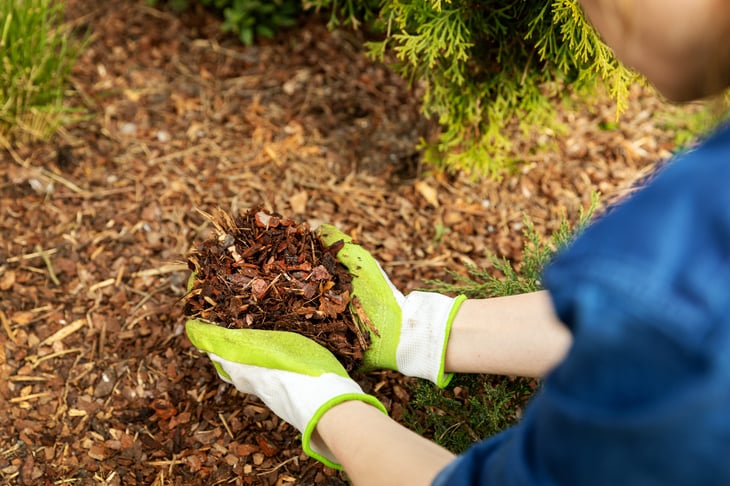
Pros:
- Easy to work with because it’s lightweight
- Relatively inexpensive
- Readily available in different sizes and colors
Cons:
- Needs to be replenished as it breaks down
- Easily displaced by wind, water, and foot traffic
- Not conducive to walking barefoot
Note: For more information on the cost of mulch, check out our pricing guide.
2. Gravel
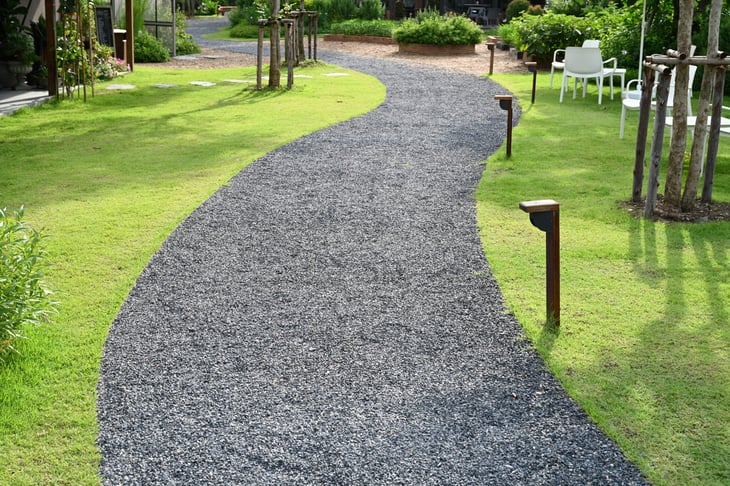
Average Cost: Landscape gravel costs $0.78 to $1.70 per square foot; pea gravel costs $25 to $67 per cubic yard
If you’re looking for something inexpensive and DIY-friendly that won’t break down like mulch, then gravel may be a good choice for your project.
A gravel pathway is a simple, inexpensive way to direct foot traffic through your garden.
You have many options for gravel or crushed stone, including river rock, pea gravel, decomposed granite, and landscape rock.
Many homeowners opt for pea gravel which is smaller and has been rounded by flowing water, so it’s more gentle on your feet.
A gravel path will last longer than mulch, and if you’re working on a large-scale project, you can typically purchase bulk quantities and have it delivered directly to your home.
Be prepared for a solid weekend (or two) of hard work. Gravel is obviously much heavier than mulch.
Gravel Pros and Cons
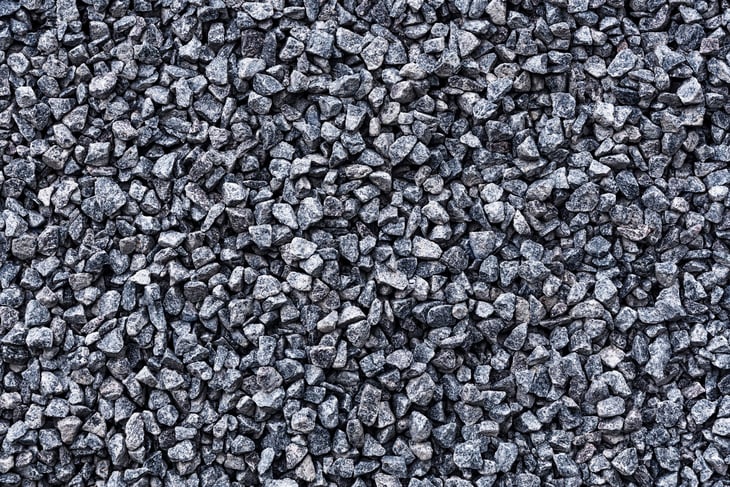
Pros:
- Available in bulk
- Available in many different types, sizes, and colors
- Simple to maintain
Cons:
- Hard on the feet and knees
- Gravel that migrates to the grass can be a safety hazard when mowing
Note: For more information on the cost of pea gravel, check out our pricing guide.
3. Pavers/Bricks
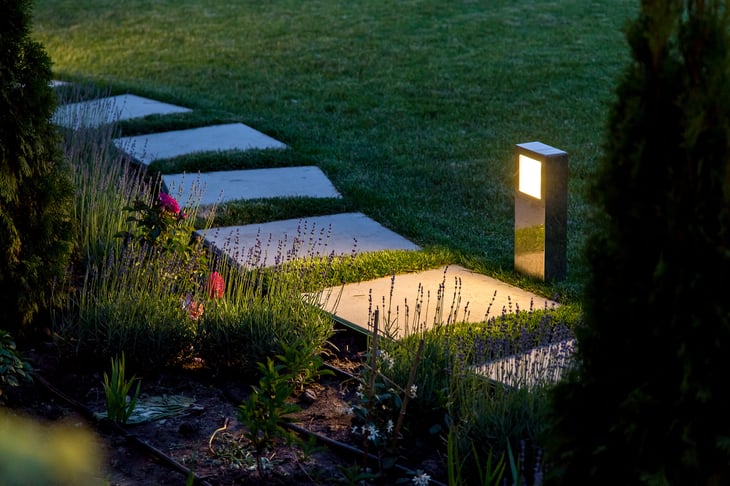
Average Cost: $10 to $30 per square foot
A paver or brick path is one of the more expensive options, but they do look gorgeous. Many material options are available, and you can customize the pattern to fit your aesthetic.
If you choose concrete pavers or bricks, you can either DIY the project or hire professional landscapers to install the path.
Be forewarned, though, the process is tedious and tiring, but the reward is high. Expect to invest the better part of a day, if not the entire weekend.
A well-installed pathway will easily last 25 to 40 years, even with heavy traffic, and requires little maintenance. Power wash it periodically when the surface is dirty and replace the sand between the pavers when needed.
It’s also relatively easy to replace a single piece if it cracks or breaks.
Pavers/Bricks Pros and Cons
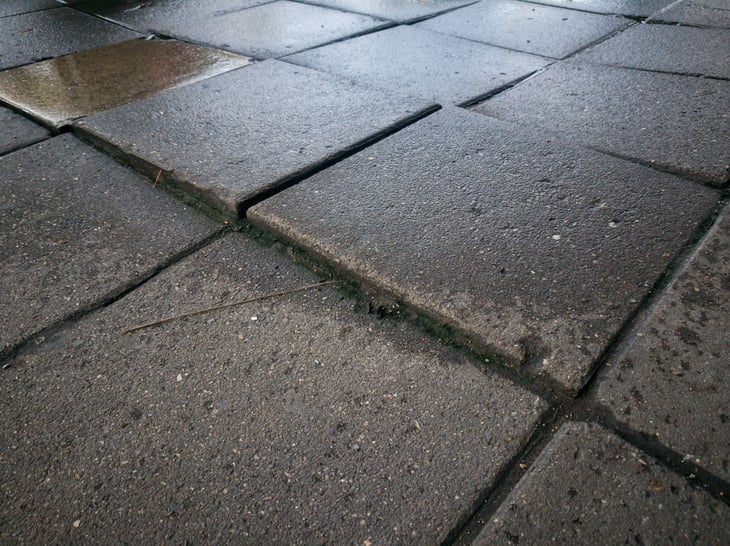
Pros:
- Flat, even surface
- Extensive design choices
- Long-lasting
- Individual pieces accommodate freeze/thaw cycles
Cons:
- Installation is expensive and labor-intensive
- Weeds grow through cracks
Note: For more information on the cost of pavers, check out our paver driveway pricing guide.
4. Poured Concrete
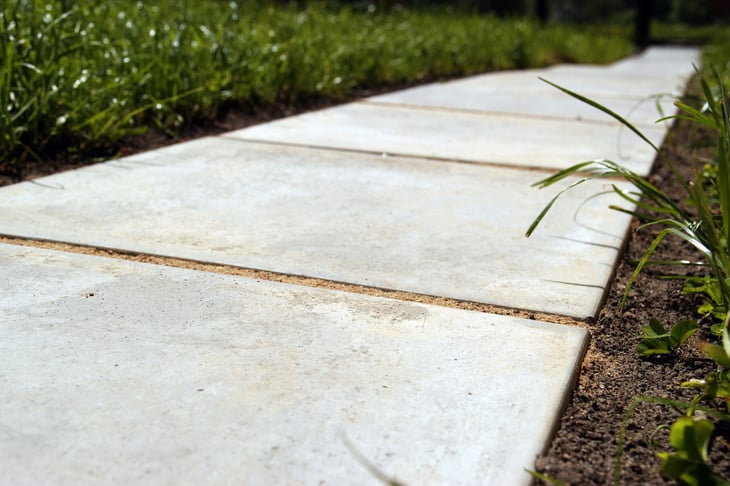
Average Cost: $6 to $16 per square foot
Concrete is a popular driveway type due to its low-maintenance needs and durability, but it isn’t as popular in garden areas.
Homeowners typically opt for more aesthetically pleasing materials, as concrete seems better suited for the front yard versus the back.
It is still a good option, though, especially in high-traffic areas.
It is another material you can install yourself or hire a professional contractor. A well-installed concrete path will last 30 to 50 years if properly maintained.
To maintain concrete, pressure wash it every few months and seal the surface every four to five years. Sealing protects the concrete surface, increasing its lifespan.
Poured Concrete Pros and Cons
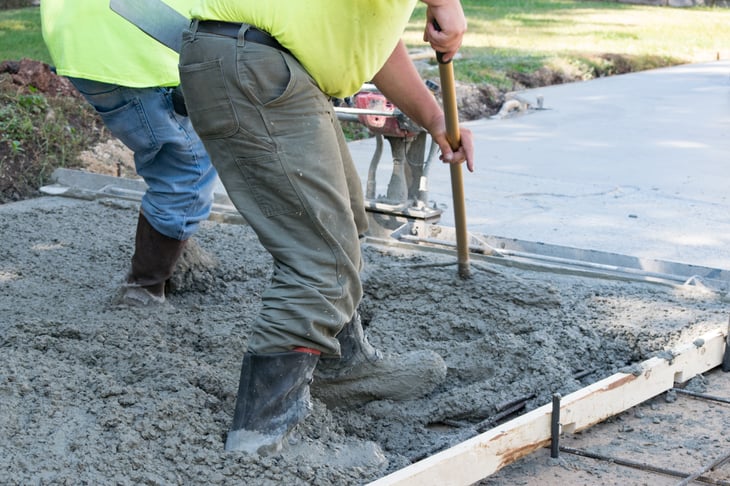
Pros:
- Holds up well in hot climates
- Easy to maintain
- Can be stained or stamped for a custom look
Cons:
- Cracks with frequent freeze/thaw cycles
- Repairs are easily visible
5. Natural Stone Stepping Stones
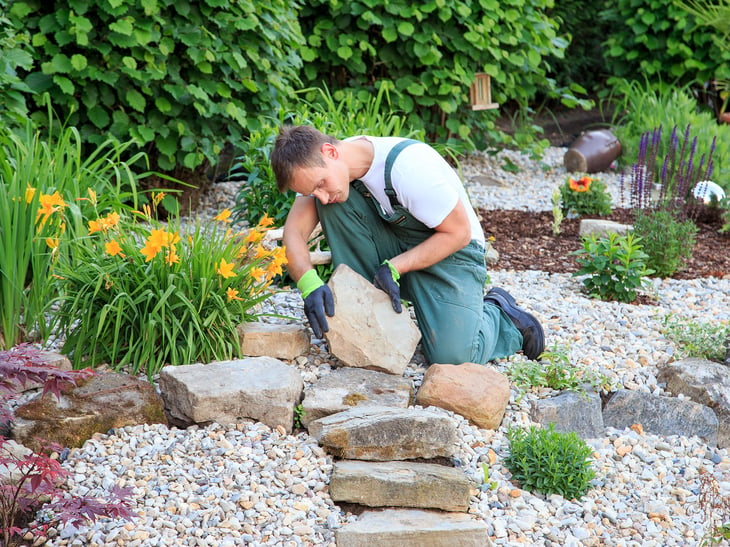
Average Cost: $6 to 10 per stone
A garden path made of natural stepping stones creates an inviting look, mixing grass and raw stone material.
These relatively thin, flat stones are commonly fieldstone or flagstone and come in various sizes. Stones can be spaced closely with small joints or placed further apart at stride length.
One of the things homeowners like about stepping stone pathways is that the outline doesn’t have to be precise.
In many cases, the stone path looks better as it meanders, and the edges of some stones lie outside the path’s edge.
Over time you may need to reset the stones if they settle unevenly, but beyond that, there is little maintenance.
You can effortlessly run the lawn mower right over them when set at the correct height. Smaller pieces may crack after years of use, but generally, this material will last indefinitely.
Stepping Stones Pros and Cons
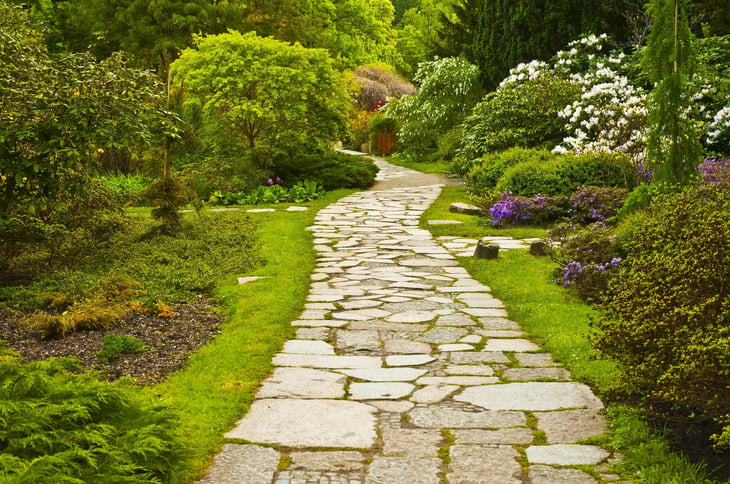
Pros:
- Semi-permanent solution doesn’t remove all of your grass
- Blends in beautifully with outdoor space
- Easy DIY option
Cons:
- More expensive than pavers because they must be excavated
- Uneven surface isn’t conducive to wheelbarrows
6. Asphalt
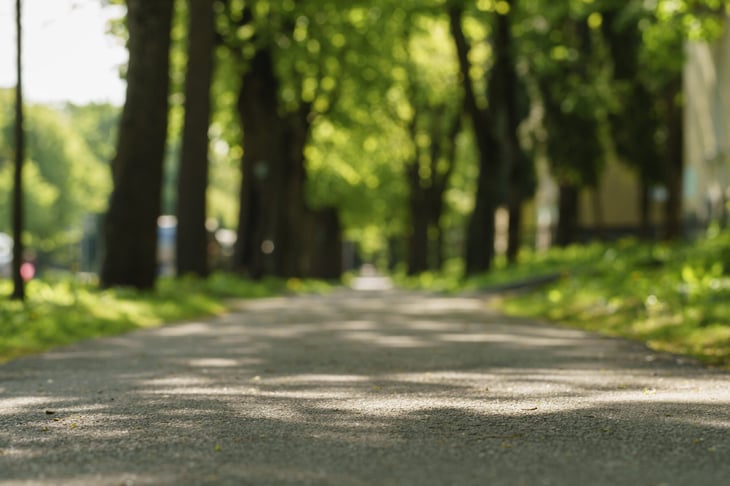
Average Cost: $4 to $6 per square foot
Asphalt is another material commonly used in driveways but less so as a garden path in yards. It is popular for driveways because it provides a nice, firm, attractive surface and handles freeze/thaw cycles well because of its ability to flex.
The truth, though, is that asphalt simply doesn’t look like it fits in your backyard as much as some of the other options.
One of the drawbacks to asphalt is you’ll need to have it professionally installed.
Plus, installation may be challenging in your backyard because of existing landscaping and equipment may be hard to get through gates and fences. Once installed and properly maintained, it will last 12 to 20 years.
Asphalt Pros and Cons
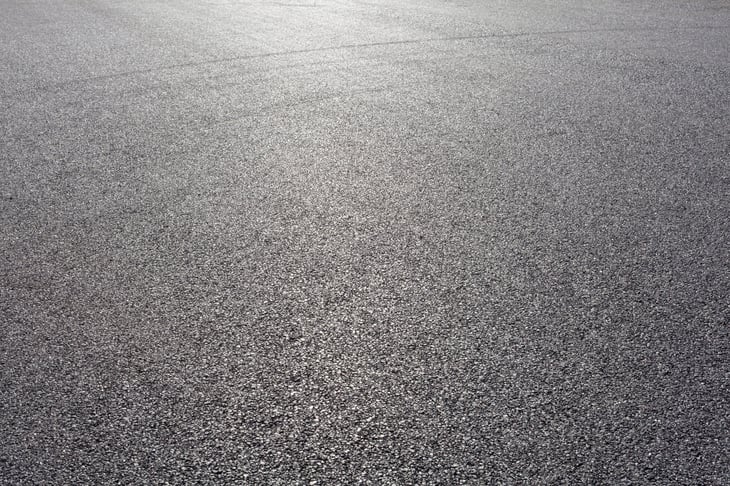
Pros:
- Holds up well in cold climates
- Easy to patch holes
- Budget-friendly
Cons:
- Gets sticky or tacky in high temperatures
- Not environmentally friendly
7. Dirt

Average Cost: $10 to $15 per cubic yard
One of the tried and true materials for a garden path is one you already have on hand – topsoil! Let’s not overlook the cost, either. If you don’t need to bring in any extra dirt, there is nothing for you to purchase.
Many people like the natural, organic feel of a dirt path and the ease of creating it. All you need to do is pull up the grass and make a level surface for strolling. You can add edging to the sides as a designated border if you want.
You’d think there wouldn’t be much maintenance with a dirt pathway, but you must periodically pull or spray weeds and grass and fill in low spots as they appear.
However, weeding needs to be done with many of the materials on our list.
A dirt path will last indefinitely if you keep the neighboring grass from encroaching.
Dirt Pros and Cons
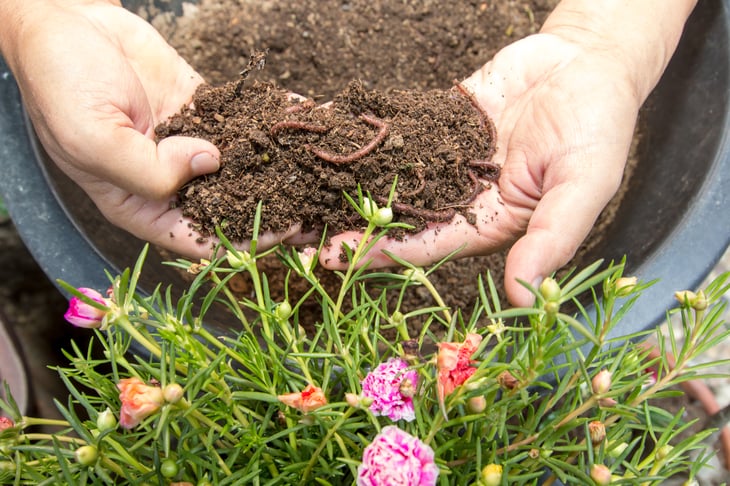
Pros:
- No need to buy material
- One of the quickest to “install”
Cons:
- Weeds grow up throughout pathway
- Messy, especially when raining
- Doesn’t look as nice as other materials
8. Wood Planks
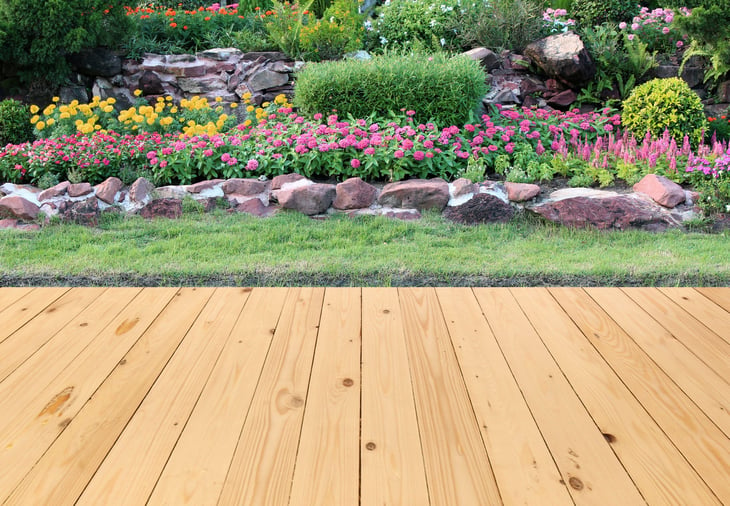
Average Cost: $3 to $8 per square foot
Wood plank garden paths offer the feel of a Japanese garden, but they are certainly suitable for any landscape style. You can customize the width of your walkway easily, and wood is much easier on your back to install than pavers or stepping stones.
You can use cedar decking boards, treated wood planks, or even planks recycled from used pallets. It all depends on the look you’re trying to achieve and how much money you want to spend.
Simple designs consist of planks laid side by side to create your walkway. More extensive designs can incorporate different levels with posts, riser boards, and joists.
Maintenance requirements depend on the chosen wood. Regardless of the type, expect to power wash the surface once or twice a season and stain it as the color fades for protection from the elements.
Wood Planks Pros and Cons
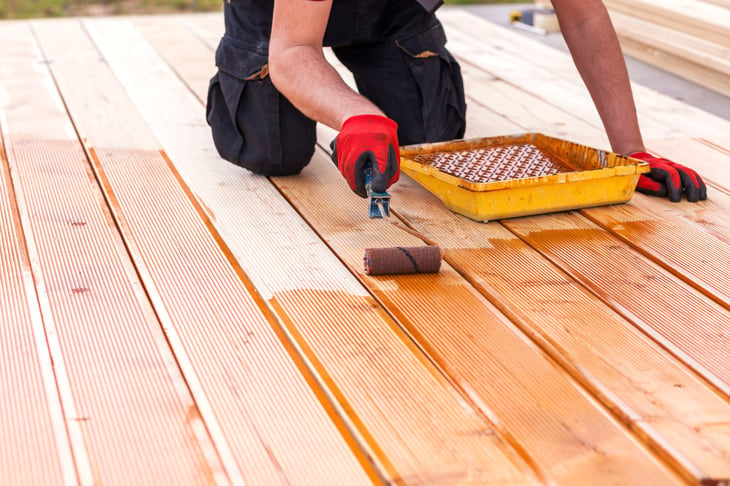
Pros:
- Can use recycled materials
- Doesn’t get muddy
- Great for sloped sites
Cons:
- Boards will need to be replaced over time
- May splinter
9. Slate Chips
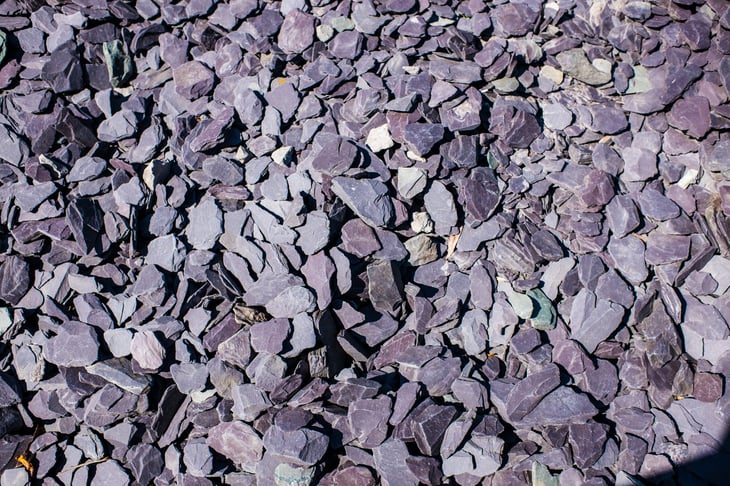
Average Cost: $2 to $4 per square foot
Slate chips are a very versatile material and make a beautiful, durable garden path that will be a focal point in your flower bed.
These thin pieces are typically 1 to 3 inches in diameter and lie flat to create a lovely textured surface. You can also buy smaller pieces (known as slate path in the industry) that are a quarter- to one-half inch in size that pack down nicely for pathways.
When building a walkway with this material, you can purchase bags of slate at your local home improvement store or have larger quantities delivered in bulk from a local landscaping or stone company.
One of the greatest advantages is that slate lasts indefinitely, so you’ll incur this cost just once.
Slate is typically available in shades of gray but can come in blue, purple, and green hues.
A bonus of slate chips is they take on a darker color when wet! And the only maintenance this walkway needs is to rake them periodically.
Slate Chips Pros and Cons
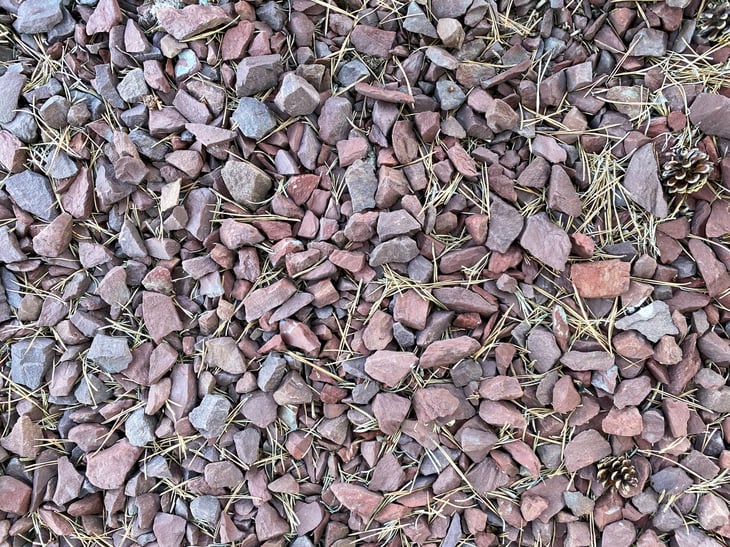
Pros
- Looks high-end
- Extremely durable
- Eco-friendly recycled material
Cons
- Not comfortable for bare feet
- Weeds may grow through
10. Rubber Tiles
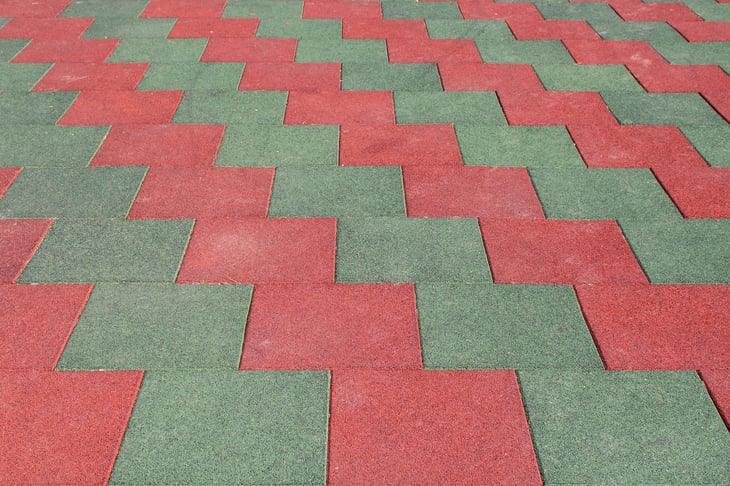
Average Cost: $8 to $11 per square foot
Similar in composition to rubber floor tiles used on garage floors, garden tiles have interlocking edges that snap together to create a continuous surface.
They commonly come in 18- to 24-inch squares and may have a surface texture that gives them the look of stone.
Made from recycled rubber, these tiles are available in different colors and thicknesses. You can expect a lifespan of at least 10 years, and they have very few maintenance requirements.
They quickly clean off with a spray of water.
Rubber tiles likely aren’t the first choice for a garden outside your front door, but they are great for backyard garden designs, especially if you’re looking for an ergonomic surface that is easy on your body.
Rubber Tiles Pros and Cons
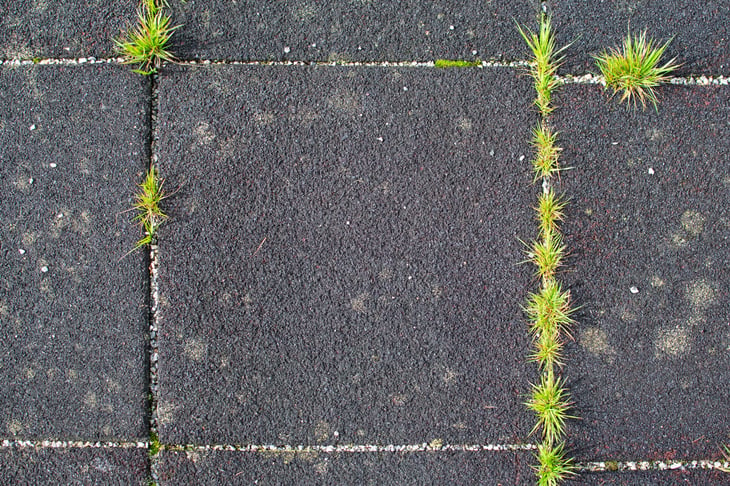
Pros:
- Great for rentals or short-term properties
- Easy to reconfigure
- Great on knees and ankles
Cons:
- Expensive compared with most other materials
- May need sand or stone underlayment
11. Rolled Mats
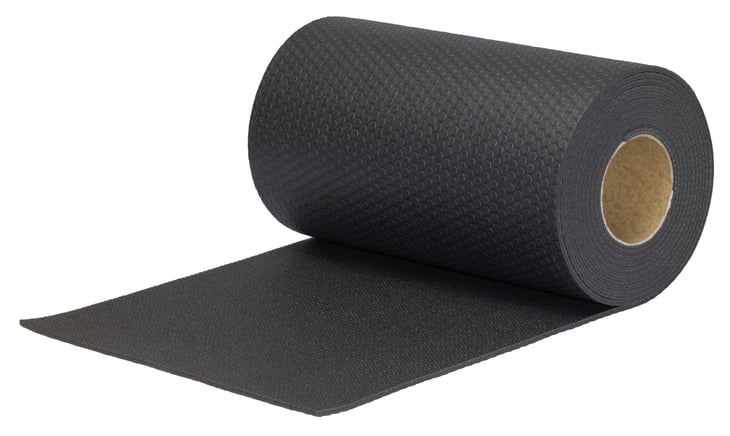
Average Cost: $1 to $2 per square foot
Rolled mats are an interesting material option. These products are newer to the market and are typically made of high-density polyethylene (HDPE), a common plastic.
Some are even made from 100% recycled materials such as tires.
Mats come in 22- or 24-inch widths, usually in 6-foot- or 8-foot-long rolls. You simply lay them where you want and unroll them, connecting lengths to create a long path.
Since they are made from pressing rubber chips or shreds together, they have a mulch-like appearance.
The longevity of this material depends on your climate. On average, you can expect to get five years of use before replacing it. Extreme heat and UV sun exposure can shorten the lifespan.
Rolled Mats Pros and Cons
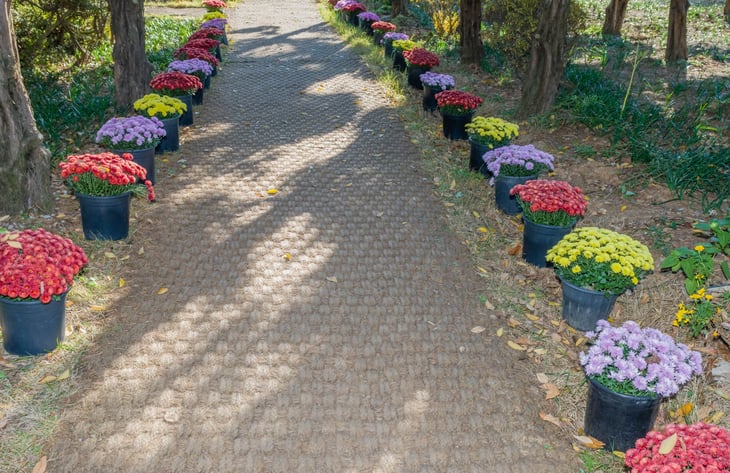
Pros:
- Perforated for water infiltration
- Available in various colors
- Less disruptive than permanent materials
Cons:
- Recycled products can leach contaminants
- Backing can separate from the rubber surface
12. Grass
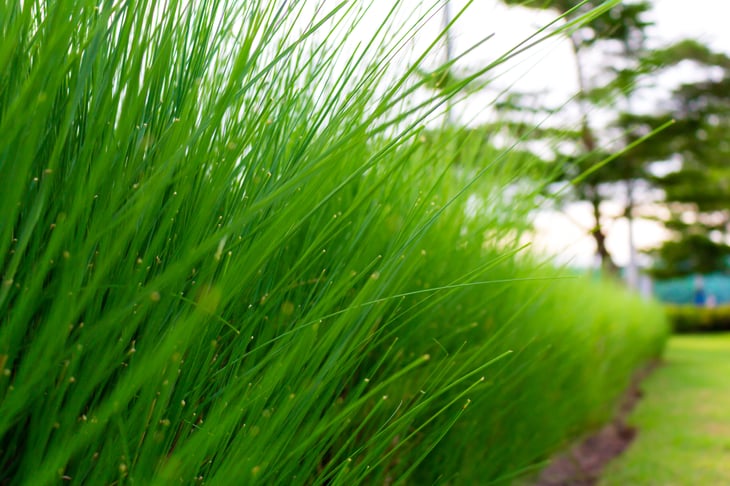
Average Cost: $0.30 to $0.83 per square foot
Okay, hear us out. We aren’t talking about letting the grass grow wildly and not putting in a designated garden path. Instead, when we say “grass,” we mean creating a beautiful, well-manicured grass pathway.
A grass pathway is an attractive option if your garden has raised beds, a lot of hardscaping, or you have a gravel garden. The greenery softens the aesthetic and creates a gentle surface to walk on.
It will last indefinitely if you keep the turf healthy.
Similarly, it may not look like a formal path like stepping stones or wood planks. If you’re considering a grass walkway, you’ll need to consider whether you want a formal look or a natural look.
The cost of materials depends on whether you’re bringing in new sod. You can construct a grass path using existing turf as long as it’s in good condition.
But if it is a little lackluster, you can remove it and install new sod.
Grass Pros and Cons
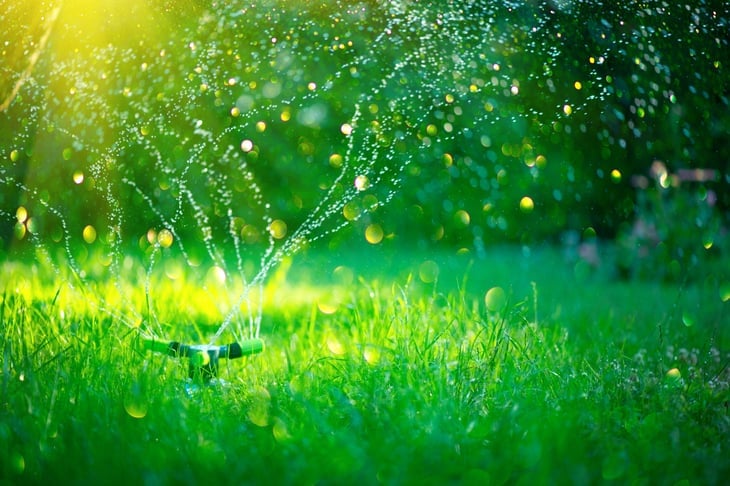
Pros:
- Lovely to walk on barefoot
- DIY friendly
- Water permeable
Cons:
- Needs constant maintenance
- May not feel like a formal path
Note: For more information on the cost of sod installation, check out our pricing guide.
Considerations When Choosing a Garden Path Material

Keep the following in mind when thinking about different materials for your project. These factors may play a part in your decision.
- How much money can you comfortably budget to spend?
- How much maintenance do you want to do?
- How long do you want the garden path to last?
- Are you looking for a DIY project or will you hire a landscape designer?
- What are your climate extremes in summer and winter? Materials perform differently under extreme heat or bitter cold.
- What are your local building and zoning codes? You may need permits if you are attaching your garden path to existing structures (driveway, patio, etc.).
How Do You Make a Garden Path?

Creating a garden path is relatively straightforward in terms of the steps, although they differ slightly because of the material you’re using.
You’ll want to first lay out the path design/placement with a garden hose to create the rough shape and size.
After that, use spray paint to mark the edges and remove the turf, leveling the ground as you go. Then, you’ll follow the necessary steps for your specific material.
What Is the Cheapest Material for a Garden Walkway?
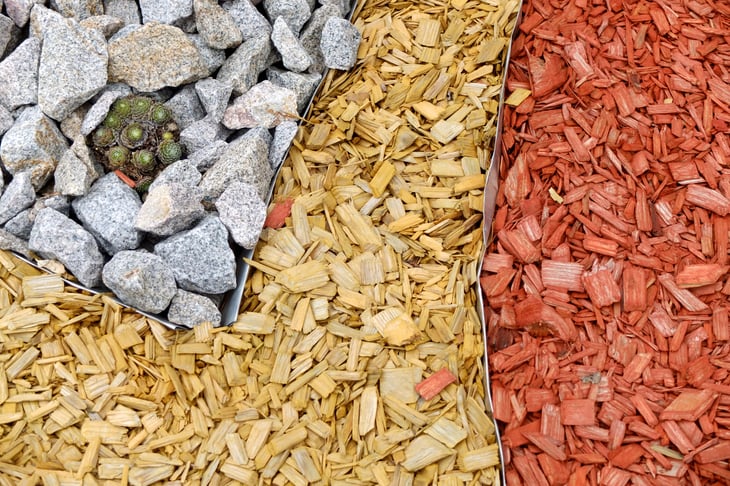
The cheapest materials are sod and topsoil. If you can use what is already available in your yard, a minimal cost is involved.
However, if you need to purchase materials, you’re looking at roughly $1 per square foot.
What Gravel Is Best for Garden Walkways?
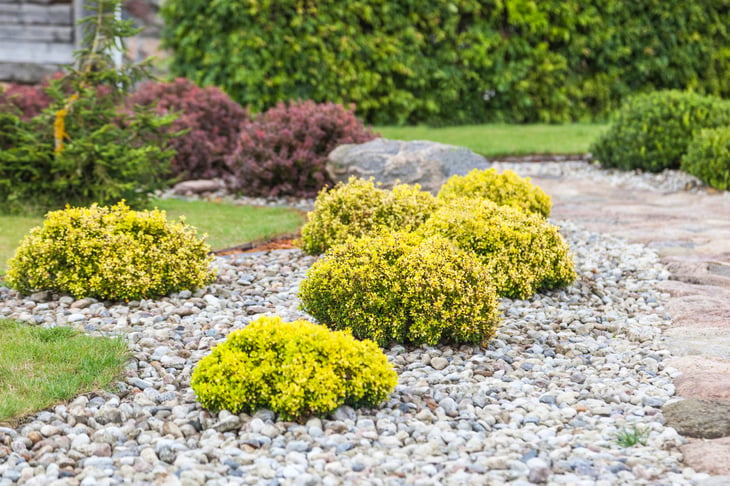
The best type of gravel is subjective, depending on what your needs and wants are for your garden walkways.
Pea stone is popular for paths because it has been smoothed and rounded by moving water. A smoother, rounder rock is easy to walk on, especially barefoot.
